|
Bachem Ba 349A Natter
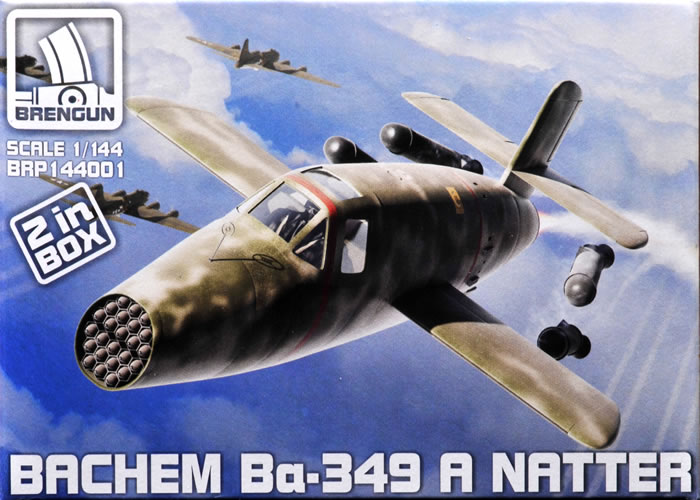
Brengun, 1/144 scale
S u m m a r y : |
Catalogue Number: |
Brengun Kit No. BRP144001 - Bachem Ba 349A Natter |
Scale: |
1/144 |
Contents & Media |
Two clear and 48 grey styrene parts, sufficient to build two models, and decals for two aircraft. |
Price: |
Available on-line from these stockists:
Click here for currency converter. |
Review Type: |
First Look. |
Advantages: |
Possibly the only 1/144 scale Natter available. |
Disadvantages: |
None apparent. |
Conclusions: |
Brengun 1/144 scale Natter is a nicely executed and simple kit; I am happy to recommend it. |
Reviewed by Mark Davies

Eduard's 1/72 Avia B.534 IV serie Weekend Edition is available online from Squadron.com
The Ba 349 Natter was a last ditch attempt by the Germans to challenge the daylight bomber raids that were pulverising their home territory. Two of the harder tasks that a pilot must master are landing and take-off, but Germany lacked time and resources to train pilots as the war neared its end. The attraction of the Natter was that it did away with the need for the pilot to control take-off or indeed land the plane. Armed with a battery of air-to-air rockets, it could take off vertically to attack a bomber formation. An autopilot controlled the Natter’s launch and approach to target, whilst a hastily trained SS pilot controlled the attack phase of the flight.
The Natter used the same liquid fuel rocket engine the Me 163 Komet. It also had four solid fuel boosters used for take-off that were jettisoned after they burned out. The Natter was to launch as a bomber formation neared its base and climb above the enemy, whereupon it would attack in a dive much as the Komet did. It would them engage the bombers with its battery of twenty-four R4M rockets that were fired off in one go. These same 73-mm rockets had proved very effective when used by the Me 262 that carried them on underwing pallets.
Some of the Komet’s operational problems would have applied to the Natter as well. It would have had similar issues with refuelling risks, short fuel supply and high closing speeds. Both planes were point-defence interceptors, but the Natter had the distinct advantage of not needing an airfield. The Allied bombers used flight paths that avoided known Komet airfields. This would be much harder to do with Natters launched vertically from hidden sites.
The Natter then descended rather like a brick with wings to somewhere that was hopefully near to its base. In fact, the Natter proved to be quite controllable during an untethered gliding test flight, albeit with a very steep glide angle. The cockpit and nose would then separate from the fuselage. This process expelled the pilot shortly thereafter, who would land using his parachute. There was to be a parachute recovery of the rocket motor and the remaining airframe as well. However, the impact of landing caused small amounts of unused fuel to explode and so destroy the motor and airframe. The wooden airframe was simple to make and therefore expendable. The rocket motor consumed more resources to build, but its loss had to be accepted too.
Bachem built thirty-six Natter BP-20 prototypes, and possibly a handful of production aircraft that were designated as Ba 349’s. All flights involved prototypes, of which unmanned take-offs consumed eighteen. A pilot successfully bailed out during an unpowered test flight when the nose separated from the airframe, which at least proved that the escape system worked. Another Natter crashed following a towed gliding flight (it had a crude fixed tricycle undercarriage). The single attempt at a manned take-off killed the test pilot when the Natter went out of control early in its take-off. Around fourteen finished and thirty incomplete Natters may have existed at the war’s end. Three versions were planned, these being the Ba 349A, B and C; sometimes referred to as the Mk.I, II and III respectively. Four Ba 349B airframes were found at the war’s end.
The Ba 349A had a battery of twenty-four Hs 217 73mm unguided rockets (although one instead used thirty-two tubes armed with 30mmm shells!); whilst the Ba 349 B & C were to be armed with thirty-two R4M 55mm unguided rockets and two Mk108 30mm cannon under the cockpit floor. The B also had a slightly longer fuselage (300mm/12”) and its booster rockets were mounted further back on the fuselage compared to the A. The wings of the Ba 349C were to have been removable to aid transportation; being inserted through the fuselage and secured by bolts, and mounted further back than on the A and B variants. The C’s tail was also different, as it was to have been mounted on top of the fin.
It seems fair to say that the Natter was not exactly a standout success for Jerry.
I am unaware of any previous Natters to 1/144 scale, so Brengun may well have cornered the market in this small scale.
The Contents
The two identical kits come in an end-opening box with digital artwork. The parts are enclosed in a single zip-lock bag along with the decals and instructions. The instructions have a parts map and use a diagrammatic format that is easy to follow. There are no written instructions, but then none are required, so simple is this kit.

Paint colours are in Czech and English, and cross-referenced to RLM codes where applicable.
The painting and decal guide consists of coloured three-view illustrations on the rear of the box.
The Airframe
The airframe parts are cleanly moulded and feature quite fine recessed surface detail, whilst the transparent canopy is clear and reasonably thin.
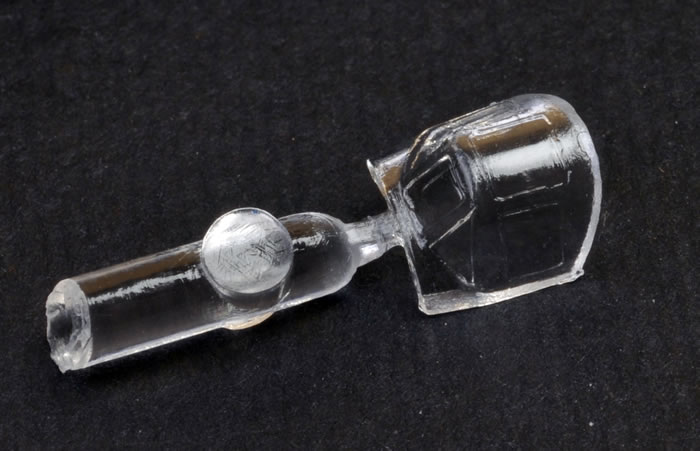
Assembly of the kit is very straightforward. It starts with the simple cockpit interior, although virtually nothing will be visible through the canopy’s small clear panels.
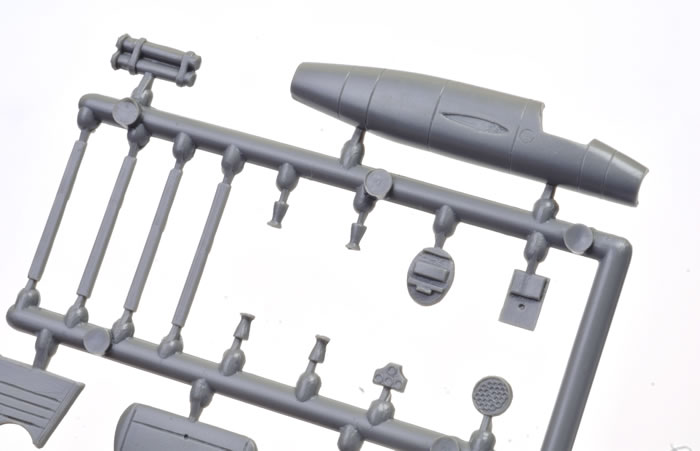
The cockpit sub-assembly, nose rocket battery and main engine exhaust fit within the fuselage before closing the two halves. The tiny wings fit into recesses within the fuselage. The horizontal stabiliser sits on top of the fin’s base, after which the remainder of the fin fits in place, whilst a ventral fin fits to the fuselage’s underside. The four booster rockets come in two pairs with separate exhaust nozzles.

The kit also provides a wooden trestle to sit the completed model on. This is not a gimmick but based on photos of the real thing.
In summary, I think this should be a simple enjoyable kit to build. Here is an image of the completed kit courtesy of Brengun:
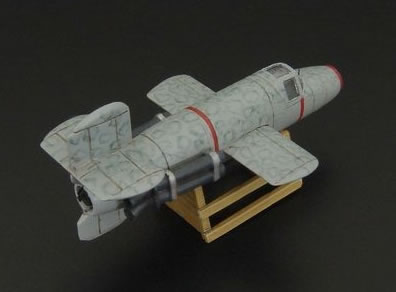
Brengun offers the same pair of kits in another boxing titled ‘Bachem Ba 349 M52/M58’ with different markings representing actual prototypes. Also available, is a PE and resin accessory set suitable for use with either boxing.
Colours & Markings
The kit offers two colour scheme options that differ in their forward underside colour.
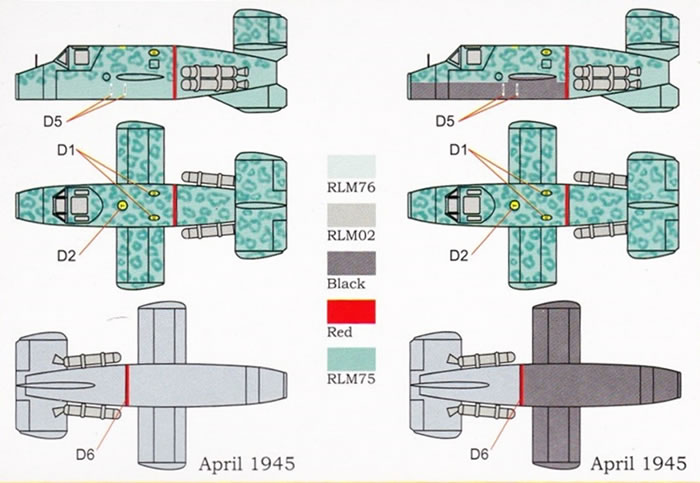
The small decal sheet appears to be of god quality, and aside from the airframe numbers, includes fuel designator and arrow stencilling, plus two red stripes.

Brengun 1/144 scale Natter is a nicely executed and simple kit; I am happy to recommend it.
Thanks to Brengun for the review sample.
Review Text Copyright © 2016 by Mark Davies
Page Created 20 July, 2016
Last updated
20 July, 2016
Back to HyperScale Main Page
Back to Reviews Page |
